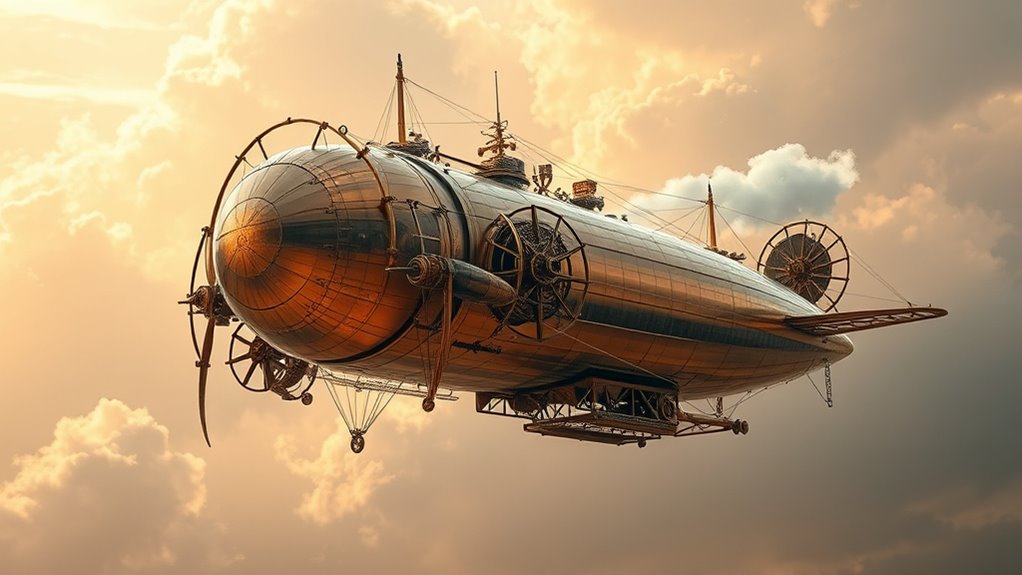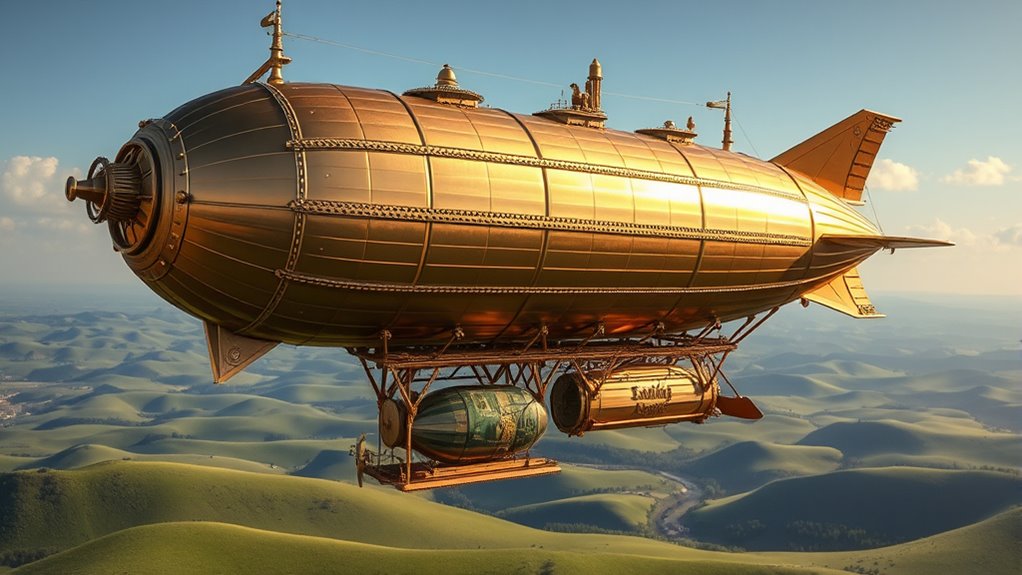In steampunk flight, you see steam-powered airships that use brass engines and propellers to generate thrust, overcoming gravity and resistance. Their sleek, elongated shapes reduce drag and help airflow around them. Controls like fins and rudders, combined with adjusting steam output, let you steer and stabilize. This blend of Victorian engineering and aerodynamics creates a graceful, efficient flight. If you explore further, you’ll uncover how these designs balance science and style for flight that’s both functional and fantastic.
Key Takeaways
- Steam engines generate thrust by driving propellers that push air, creating lift and forward motion.
- Streamlined hulls reduce air resistance, enhancing aerodynamic efficiency and stability during flight.
- Fins and rudders control direction and altitude by manipulating airflow and adjusting ballast or engine power.
- Propeller blade shapes are designed to optimize airflow, maximizing thrust while minimizing turbulence.
- Material choices like brass and layered fabrics influence airflow, structural strength, and overall aerodynamic performance.

Have you ever wondered how steampunk pioneers might have made their fantastical flying machines work? It all comes down to a fascinating blend of steam powered propulsion and Victorian aerodynamics. These inventors envisioned airships that harnessed the power of steam to lift and propel them through the skies, combining the elegance of Victorian engineering with the raw power of steam engines. Imagine a massive, brass-clad airship, its engine churning out steam, pushing against pistons and gears that translate that force into movement. This steam powered propulsion is the backbone of steampunk flight, providing the thrust necessary to overcome gravity and atmospheric resistance.
In the steampunk universe, Victorian aerodynamics plays a vital role. Pioneers of the era observed how air flows around objects, understanding that the shape and surface of their flying machines could influence lift and stability. They might have used elongated, streamlined hulls designed to reduce drag, much like the early airship designs of the late 19th century. These shapes help air currents smoothly flow over the vessel’s surface, minimizing turbulence and energy loss. The materials used—brass, copper, and layered fabrics—were chosen not only for their aesthetic appeal but also for their functional properties, helping maintain structural integrity while allowing airflow to pass efficiently.
To achieve controlled flight, steampunk engineers would have relied on a combination of ballast, adjustable fins, and rudders. These elements, inspired by Victorian aerodynamics, allow pilots to steer and stabilize the airship amid changing wind conditions. The fins, often elaborately decorated, not only served a practical purpose but also added to the visual grandeur of these flying contraptions. Balance was key; adjusting the steam engine’s output or shifting ballast would alter the airship’s altitude and direction, giving the pilot a degree of mastery over the flight path.
Furthermore, the principles of Victorian aerodynamics informed the design of propellers and other moving parts. They would have studied how different blade shapes affected airflow and thrust, making adjustments to optimize efficiency. The interplay between steam-powered propulsion and aerodynamics created a delicate dance: the steam drives the propellers, which push against the air, generating lift and movement, while the aerodynamic shapes ensure that this energy is used effectively without unnecessary resistance.
In essence, steampunk flight combines the ingenuity of Victorian-era scientific understanding with imaginative engineering. By harnessing steam powered propulsion and Victorian aerodynamics, these fantastical flying machines could navigate the skies with both power and grace, embodying a vision of flight rooted in the technological marvels of a bygone era.
Frequently Asked Questions
How Do Steampunk Airships Navigate Through Turbulent Weather?
You navigate steampunk airships through turbulent weather by closely monitoring weather patterns and adjusting your course accordingly. To mitigate turbulence, you can tweak the ballast and use control surfaces like rudders and vents to stabilize the vessel. Constant communication with ground crews and weather stations helps you anticipate sudden shifts, allowing you to adapt quickly and guarantee a smooth ride even in challenging conditions.
What Materials Are Used for Constructing Authentic Steampunk Airship Hulls?
Like the legendary Nautilus, your steampunk airship’s hull combines metal alloys such as brass and copper with sturdy wood composites, creating a resilient, vintage look. These materials withstand the rigors of the skies while maintaining authenticity. You might also see riveted steel panels and leather reinforcements, giving your vessel both durability and steampunk charm. This blend of metals and woods captures the essence of Victorian innovation and adventure.
How Do Steampunk Airships Achieve Stable Altitude Without Modern Tech?
You achieve stable altitude by adjusting ballast systems, which involve adding or removing weight to control your airship’s rise or fall. Rigid hulls provide structural support, maintaining shape and stability during flight. By carefully managing ballast, you can keep your steampunk airship steady in the sky, even without modern tech. This balance allows for smooth navigation and control, making your voyage both authentic and reliable.
Can Steampunk Airships Withstand Extreme Temperature Variations?
Imagine your steampunk airship as a resilient vessel steering a fiery forge. It can withstand extreme temperature variations thanks to advanced insulation techniques that act like a protective shield, preventing thermal expansion from causing damage. These materials and design features ensure the hull remains stable and flexible, allowing your airship to endure harsh climates without losing altitude or structural integrity, maintaining a steadfast journey through the unpredictable skies.
What Are the Safety Mechanisms in Steampunk-Inspired Airship Designs?
You’ll find that steampunk-inspired airships include safety mechanisms like safety harnesses to keep passengers secure during turbulence or sudden movements. Emergency ballast systems are also incorporated to help stabilize the airship if it encounters technical issues or needs to descend quickly. These safety features ensure that, despite their vintage aesthetic, steampunk airships prioritize passenger safety and operational control during any unforeseen circumstances.
Conclusion
As you imagine steampunk airships soaring through the sky, you can see how their physics resemble a delicate dance, balancing aerodynamics and steam power. Just like a well-tuned instrument, these vessels rely on careful design and understanding of forces to stay aloft. By mastering these principles, you can appreciate the blend of science and imagination that makes steampunk flight both fascinating and feasible—like a clockwork universe ticking perfectly in harmony.









